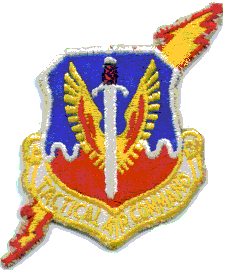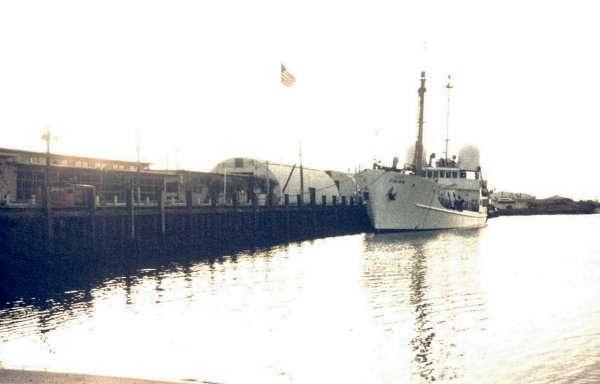|
Sembach AB
Hahn AB
Bitburg AB
Kadena AB
Osan AB
Tainan AB
Lowry AFB
Wheelus AB
Orlando AFB
Camp Happiness
Missile History I
Missile History II
Missile History III
The MM-1
Collectibles
Home Page
|
Camp HappinessDetachment 2, 4504th Support Squadron
4504th Missile Training Wing
Cape Canaveral, Florida

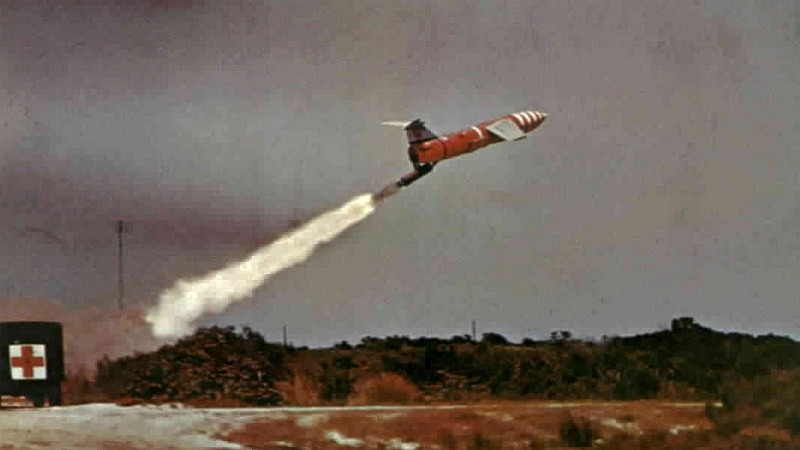 B-61 (TM-61C) Matador - USAF Photo - courtesy of Robert Bolton
 |
|
A TM-76B during pre-launch check at Cape Canaveral while mounted on a TM-76A translauncher during Research and Development testing. Research continues on the guidance system used and how the bird was launched. Notice the ARW-59 Command Guidance antennae mounted on bottom the vertical stabilizer, and the single air conditioning hose entering the warhead section but not the nose A/C as in operational missiles.
photo: Office of Information Air Force Missile Test Center, Cape Canaveral - Atlantic Missile Range
Courtesy of Robert Bolton (olliesnapper@gmail.com)
|
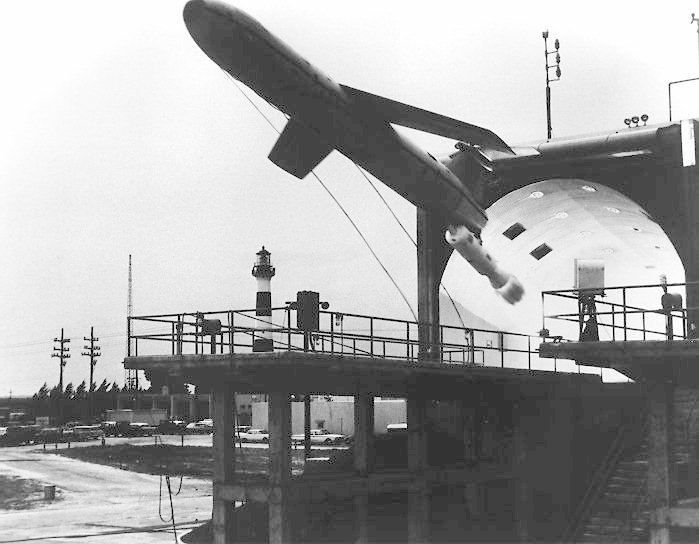

"I was permanent party on the last 12 to 15 or so launches at the Cape. I was on the launch crew that fired the missile that destructed right in front of the launch facility. The thing didn't even make it to the ocean. I know because Bill Hanson, Stan Pesotski and I were sent out into the palmettos to help salvage whatever was left of it."
"Captain Van Sohn was the launch commander. On this particular launch we loaded explosive squibs in the nose cables. In previous launches we'd always run out and disconnect the nose cables at the last minute and store then in the adjacent launch bay for the next launch then scurry back into the block house with a minute or two to go in the count. On this particular launch the Captain wanted a combat simulated launch." "When the missile was launched the nose cables blew off and the blast from the booster bottle blew them out the exhaust tube. Some wrapped around the power lines across Cape Road, shorting out Cape Power. When Cape Command Destruct lost its signal due to the power outage the missile went into auto destruct. Which meant the wings were sheared off with primer cord. The chain link perimeter fence was blown over thanks to some of the nose cables hitting it also."
 Photo courtesy of Glen Curl, on far left with the SOTE Crew at the Cape, 1961
"I'll never forget sleeping under mosquito nets in those non-air-conditioned Quonset Huts. We were provided USAF issue, olive drab, aerosol cans of DDT. We periodically woke up and sprayed the inside of the mosquito net. When it rained we spread our raincoats over the mosquito net because those Quonsets leaked. Is it any wonder the USAF paid us hardship pay? Can you believe some of those old Quonsets are still in use today ? The Canaveral Port Authority use some for storage and Brevard County has the remainder."
"Remember the bus we rode to work in ? Called it the Blue Goose. When it got close to payday and we were down to our last few dollars that's how we went to town. Couldn't afford beer & gas. Had to be creative in hiding the Blue Goose within walking distance of the Missile Lounge. Usually just parked it with a note that it was broken down and a wrecker was coming for it."
"While sleeping conditions were tough unless you had a big fan, the food was fantastic. The First Sergeant traded food with the Tug Boats. No other USAF chow hall ever served long island roast duck or oysters on the half shell."
"Have a great day and thanks for the memories." Dick Beal (rbeal@cfl.rr.com) |
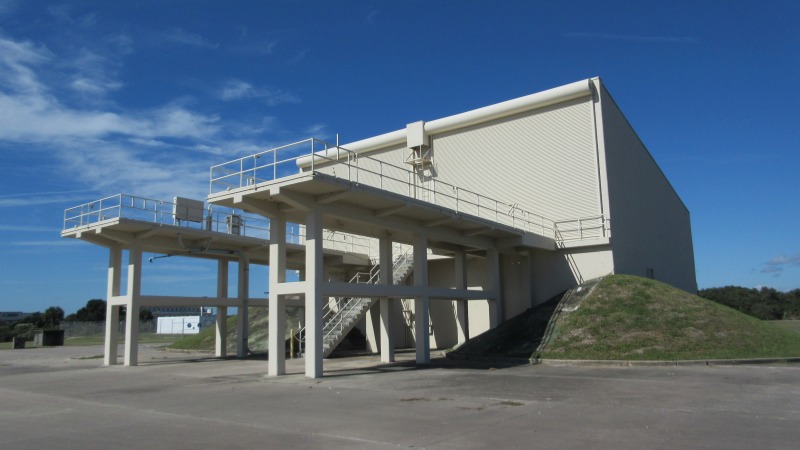 Pad 22 photo courtesy of George Mindling . Photo taken October 2015




Original member of the 1st PBS, John Gibbs, visits the U.S. Air Force Space and Missile Museum at Cape Canaveral Air Force Station, FL, 2014.
An original XB-61 Matador is in the background.
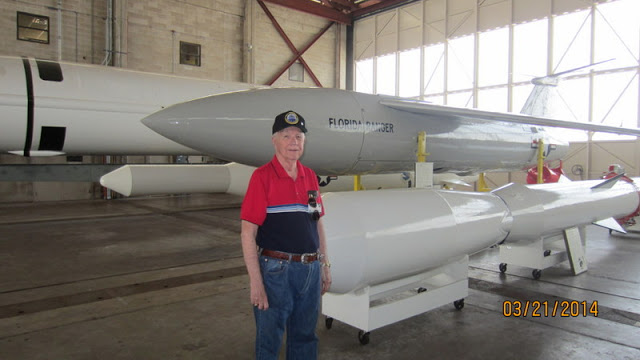

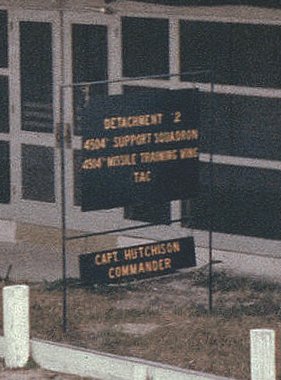
"Front of Camp Happiness - notice detachment sign. I did some tweaks on this one too. I hope people enjoy these." Les Smith (LTSmith39@aol.com) ex-Matador Troop | | |
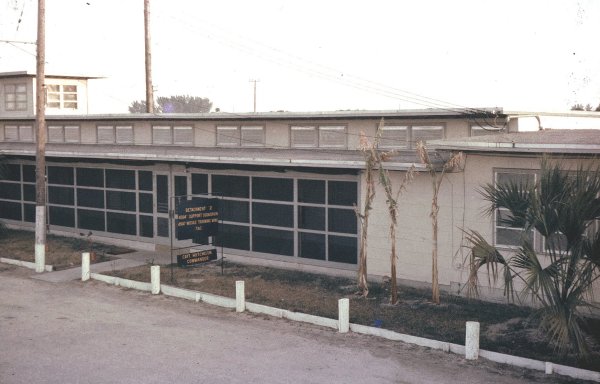 |



U.S. Air Force Tactical MissilesBy the Editors of this Website!Beyond the Web Page... The only book devoted exclusively to the Matador and Mace Tactical Missiles. The book reveals the story from the initial idea that became the first U.S. pilotless bomber, through the politically troubled development of the ever evolving deployment methods of the Matador and Mace Tactical Missiles. It covers the Units, Groups, Squadrons and Wing that fielded the missiles. From the United States test sites, Europe, Asia and North Africa nothing is omitted. All phases of the application of these two missiles by the U.S. Air Force (and West German Luftwaffe) are included, from the first tentative launches of the XSSM-A-1 Matador in January 1949, to the tense alert duty of the Cuban Missile Crisis, and the final launch of a MQM13A in May of 1977. The maintenance, logistics and launch, the men, equipment and tactics are all there. |
"Bob, George, I finished your book 2 days after I received it. Couldn't put it down. It was incredible reading and incredibly detailed information." Kent Washburn (KWASH55@aol.com) Mace B, Kadena, Okinawa
"George and Bob. I want you both to know how much I enjoyed reading and how much I admire and appreciate what you have accomplished in developing and publishing "The Pioneers". It is truly an outstanding piece of work, reflecting the time and effort required to produce it, but is also a formidable contribution to our military history. I mentioned in some earlier correspondence that I was a little disappointed in the relatively small amount of information regarding the Operating Location/Guidance Sites but you largely made up for it with this magnificent book." Dale Lake (daleflake@yahoo.com) 601st Tactical Control Squadron, 38th TMW, Hamm, Germany
"I just finished your book, The Pioneers, et al. Please accept my "job well done!" Not only is it informative, but it's very readable. I'd also like to complement you on how well you footnoted it. You have shown that a scholarly work can be both instructive and enjoyable." Michael Roof (lavinaschnur@hotmail.com) SGM USA (Ret.)
| 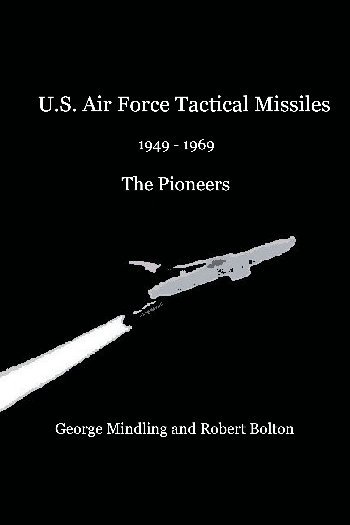 ISBN 978-0-557-00029-6
"Very good work with great detail." Col. Charlie Simpson, USAF, Retired
Executive Director
Association of Air Force Missileers
"George, the book arrived on Tuesday while I was off to France. Of course, I quickly read the chapter about Germany's quiet step into the realm of nuclear armament. You know, this is still a widely ignored fact over here...
...For me it is fascinating to see what the picture really was in the 1950s and 1960s as opposed to what the official communication of the time wanted people to believe. A fascinating book shedding some light on the early days of tactical nuclear missiles as well as the political background that even today is still largely hidden behind the propaganda of the time. Can't wait to read the rest of it." Burkhard Domke
Harsefeld, Germany
| "I have your excellent book on USAF tactical missiles. I actually witnessed the decommissioning of the Maces at Wüscheim back in 1966." Paul Offen
Talitha, Tye Common Road
Billericay
Essex CM12 9PX
UK
"I just wanted to drop you a line and tell you how much I enjoyed the book that you and Bob wrote. The history was of particluar interest to me and my brother who was a history Professor at the University of Wisconsin. He also thought the book was well written, and he now knows what his little brother, (me), did while in Germany for three years." George Joseph Snyder (gjsnyder@lanset.com)
71st TMS, Steinborn, Germany
"...by the way, I read your book, it was great, thanks for writing it." Hack Hunton (hack@sstelco.com) Mace B, Kadena, Okinawa |
US Air Force Tactical Missiles ©2008 - George Mindling and Robert Bolton | Inspired by the 38th TMW Website, George Mindling and Robert Bolton co-authored US Air Force Tactical Missiles 1949 - 1969: The Pioneers ©2008, the story of America's first operational missiles, from the Matador to the Mace, from Taiwan, Korea, and Okinawa to Germany, including Lowry, Orlando, Holloman, Santa Rosa Island at Eglin, and even Camp Happiness! |
|
Dieses Buch ist ein Muss für alle, die im Rahmen ihres Dienstes bei der U.S. Air Force mit den frühen Marschflugkörpern zu tun hatten, aber auch für deutsche Militärarchäologen, die in der Eifel, im Hunsrück oder im Pfälzer Wald schon über rätselhafte Hinterlassenschaften gestolpert sind. Nach mehr als 40 Jahren wird endlich eine Fälle von Fakten, Informationen und Geschichten zu den zwischen 1954 und 1969 in Deutschland stationierten, mit Automwaffen ausgerüsteten amerikanischen Matador und Mace auf den Tisch gelegt. Ausführlich und lebendig erzählen George Mindling und Bob Bolton von den jungen Missilemen, die im März 1954 erstmals in Bitburg ankamen - noch ganz grün im Gesicht, weil auf dem Atlantik schwerer Sturm geherrscht hatte. Von den T-33-Flugzeugen, die aus übungsgründen so taten, als wären sie Matador-Flugkörper, über die Startstellungen hinweg in Richtung deutsch-deutsche Grenze donnerten und sich von der Gegenseite nur nicht erwischen lassen durften. Oder von der Kuba-Krise, als die US Air Force Europe auf DEFCON 3 ging und an die Mechaniker in Bitburg Munition für ihre Karabiner ausgegeben wurde.
Augenzeugen sagen dazu: "Wir hätten die Vögel auf jeden Fall innerhalb von 15 Minuten in der Luft haben müssen!" Es ist lebendige Militärgeschichte, die nun nicht der Vergessenheit anheimfällt, sondern jedermann zugänglich wird - auch für die ortsansässige Bevölkerung, die heute endlich erfährt, was sich damals in ihrer Nachbarschaft zugetragen hat. Den beiden Autoren gebührt der Dank.
Klaus Stark (klaus_stark@t-online.de)
Berlin, Germany
This book is not only a must for all those who served in the U.S. Air Force with the early cruise missiles, but also for German military archeologists who have been puzzling over relics stumbled across in the Eifel, the Hunsrück and the Palatinate Forests. After more than 40 years, we finally have a wealth of facts, information and stories, from 1954 to 1969, of the nuclear equipped American Matador and Mace missiles stationed in Germany placed on the table.
With detailed and vivid descriptions, George Mindling and Bob Bolton talk about the young Missilemen who arrived for the first time in March, 1954, in Bitburg - still green in the face, having prevailed the Atlantic crossing in major storm. Of the T-33 aircraft which practiced as if they Matador missiles launched in the direction of German-German border, or from the Cuban missile crisis, when the U.S. Air Force Europe went on DEFCON 3 and was issued ammunition to the mechanics in Bitburg for their rifles. Eyewitnesses say: "We would have to have the birds in the air in any event within 15 minutes!"
It is vital military history that is prey to oblivion, but is now accessible to everyone - even for the local population, which today finally learns what happened at that time in their neighborhood.
The two authors deserve thanks for saving the history.
Klaus Stark,
klaus_stark@t-online.de
Berlin, Germany
|
 "Just visited the Camp Happiness site and boy, did that bring back memories!I was a student at Orlando, in training for Korea Launch Crew duties from February to July of 1959. Of course we stayed at Camp Happiness during our launch training at the Cape - we launched two Matadors. This photo is especially interesting to me because a fellow airman, one Ron Remick and I were able to commandeer the upstairs "lookout" for our bivouac while we were there. Great views, but the mosquitoes got us good!" "Thanks for those photos. Were we ever really that young?"
"Regards,"
Art Arrowsmith (arthura@macconnect.com)
Launch Crew #6
Flight Controls
310th TMS, 58th TMW
Osan, Korea 1959-1960 |

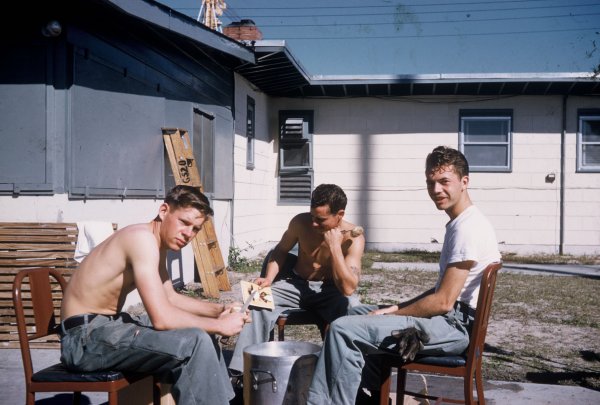
Aerospace Technicians using the aerospace weapons of tomorrow...
Now you know why it was called Camp Happiness! |
"Here's the pics, I did some modification to the dock picture - if you want the original - I can send that. Nice sunset - but the buildings were too dark. Doing KP was myself (shirt on) - I don't remember the other two guys - maybe someone will recognize them."
Les Smith (LTSmith39@aol.com) ex-Matador Troop Photos from Les Smith (LTSmith39@aol.com) |

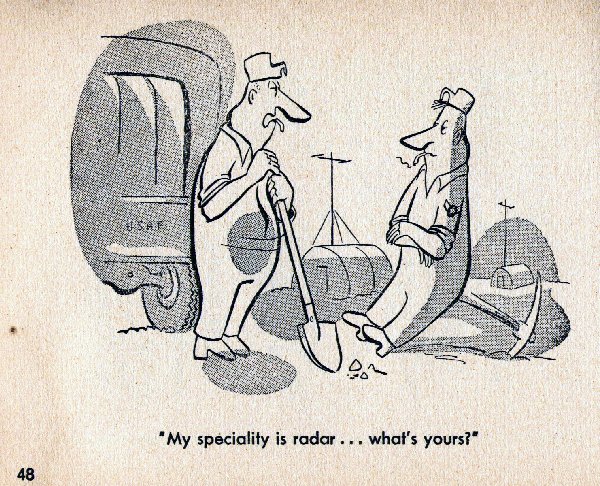 | From the book "Mox Nix", by Jack Niles and Jim Dye, published in Germany in 1957 |

Take a Virtual Tour of the Mace Hard Site Complex 21/22 at the Cape "I'm glad you enjoyed the updates. I can't tell you why the Air Force chose to refurbish some of their Complexes. I've seen some blockhouses redone, but they seem to be usingthose for storage or meeting space. Why they rehabbed the launch structureis a mystery, but I'm glad they did it." "Sorry, no photos or substantial info on Camp Happiness. I've beencorresponding with Charles Scott (Mace launch crew #5), and he mentionedthat he stayed there. His recollections include that there were severalquonset huts, they ate good, and the fishing after work was great!" "If you have any historical photos you think might add to the site, letme know. I'd be especially anxious for any photos you had of Complex 22, theblockhouse, or the LCC. Thanks again,"
Rob Svirskas (robsv@cox.net) Virtual Tour of the Cape |

|
This page is in no way sponsored or endorsed by the United States Air Force.
Opinions and views expressed are those of the author and not necessarily those of the Department of the Air Force.
|
All Contributions remain the property of the original owners
All Contributions used with Permission Web Page Design and Development by
George Mindling - Port Charlotte, Florida
©George Mindling - 2003-2006, 2018 All Rights Reserved
|
